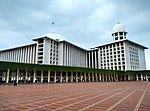Bedug
 A bedug in Istiqlal mosque, Jakarta. | |
| Percussion instrument | |
|---|---|
| Other names | Beduk, Bedhug |
| Classification |
maritime Southeast Asia |

The bedug (
Overview
A bedug is a large double-headed drum
Unlike the more frequently used kendang, the bedug is suspended from a frame and played with a padded mallet. The bedug is as large as or larger than the largest kendang and generally has a deeper and duller sound. The drum has pegs holding the two identical heads in place, similar to the Japanese taiko, and its pitch is not adjustable.
Usage

The bedug is not used in most gamelan performances, although it is included in some
The bedug is commonly used in
The bedug is also used to celebrate
The tradition is also known among Sarawakian Malays who know it by the name teter.[7]
Among the Muslim Maranao people of the southern Philippines, a similar and smaller drum is used for announcing prayer times, known as the tabu or tabo.[8]
See also
- Indonesian mosques
- Islam in Indonesia
- Islam in Malaysia
References
- ^ a b c "Beduk". National Arts and Cultural Department. Ministry of Tourism, Culture and Arts Malaysia. Archived from the original on 2017-02-14. Retrieved 15 May 2021.
- ^ ISBN 978-0-520-25549-4.
- ^ ISBN 978-1-920942-30-4.
- ISBN 0-19-580413-9. Page 47.
- ISBN 978-1-4051-2957-2.
- ^ "Celebrating the Fasting month of Ramadan and Lebaran in Indonesia". Expat.or.id. Retrieved 20 April 2021.
- ^ "Teter beduk amalan tradisi Melayu Sarawak". Astro Awani. 9 May 2021. Archived from the original on 2021-05-15. Retrieved 15 May 2021.
- ^ "Maranao Drum (Tabu)". National Museum Collections. Archived from the original on 28 June 2021. Retrieved 28 June 2021.
External links
- NIU site on the bedug, with illustration Archived 2020-02-25 at the Wayback Machine
- Virtual Instrument Museum Archived 2015-02-24 at the Wayback Machine




